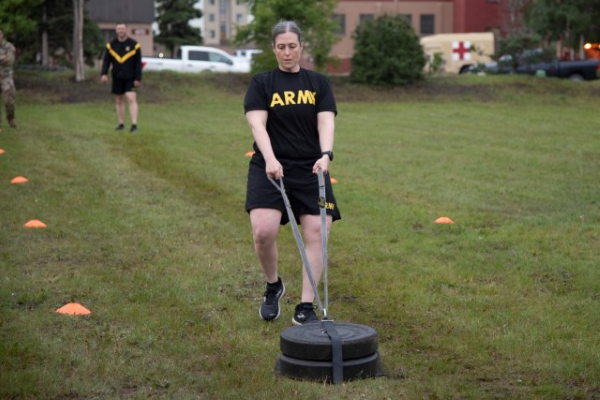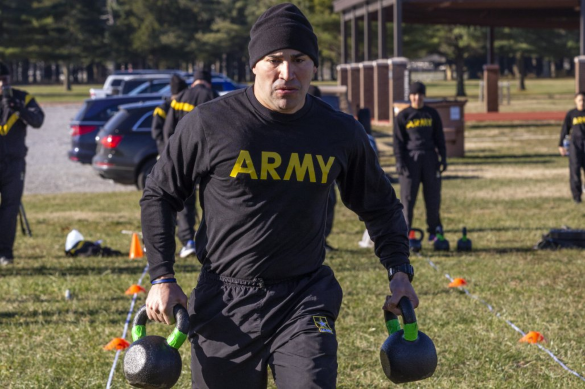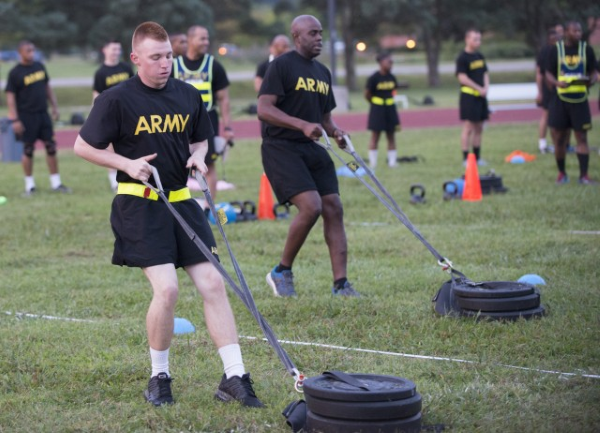Army soldiers, no matter their rank, age, or gender, are required to take and pass the Army Combat Fitness Test (ACFT).
The ACFT is made up of six events, designed to test physical fitness and ability as a determining factor for combat readiness.
The sprint-drag-carry (SDC) is the fourth event of the ACFT.
The SDC measures a soldier’s strength, endurance, agility, and anaerobic capacity.
Related Article – Army Combat Fitness Test (ACFT) Standards
Table of Contents
What Is Sprint-Drag-Carry?

During the sprint-drag-carry event, a soldier is tested on their physical ability to move quickly through five “shuttles.”
These shuttles take place in the following order: sprint, sled drag, laterals, kettlebells, and sprint.
The goal is to perform each shuttle correctly in the shortest amount of time.
This event is an assessment of a soldier’s quickness, cardiac and muscle strength, endurance, and speed.
These abilities and movements are important for combat readiness. For example, a soldier may find the need to:
- React quickly to direct or indirect fire
- Rapidly build a fighting position
- Extract a casualty from a vehicle or other area and carry them to safety
- Carry ammunition of a fighting position or vehicle
The SDC is the fourth of six overall ACFT events, taking place after the hand-release push-up and before the plank events.
SDC is a field test requiring two 40-pound kettlebells and a 90-pound sled.
Description Of Each SDC Shuttle In Order:
- During the first sprint shuttle, the soldier must sprint 25 meters from a start line, touch the 25m line with their foot and hand, and sprint back to the start line.
- During the next shuttle, drag, the soldier will pull the sled backward until the entire apparatus crosses the 25m line and then turn to pull the sled back until it fully crosses the start line.
- Following the drag shuttle, the soldier will perform laterals for 25m, touch the line with their foot and hand, and then perform laterals back to the start line. They must face the same direction back and forth to ensure they lead with each foot. Feet should not cross during the lateral shuttle.
- The carry shuttle requires two 40-pound kettlebells. The soldier must grasp one in each hand, run to the 25m line, step on or over the line with one foot, turn, and run back to the start line. If any kettlebells are dropped, the soldier will resume carrying them until the shuttle is finished.
- The final sprint shuttle takes place after the soldier places the kettlebells on the ground. They must sprint 25m, touch the 25m line with foot and hand, and sprint back to the start line.
- The time is stopped and recorded when the soldier crosses the start line after the final sprint shuttle.
SDC Test Instructions
Step 1 (Starting Position): – Assume the prone position with the top of your head behind the start line.
Step 2: Once you hear the command ‘Go!’ quickly stand up and sprint 25 meters down, and 25 meters back. Be sure to remain in your lane and touch the 25m line with your foot and hand before turning.
Step 3: Grab each of the sled’s strap handles. Move and pull the sled steadily backward until the entire sled is over the 25m line; then turn around and do the same thing to cross the start line.
Step 4: Face one side for a lateral run for 25m, touch the 25m line with your foot and hand, and then return to the start line facing the same direction. Do not cross your feet during laterals.
Step 5: Pick up a kettlebell in each hand and run to the 25m line. Step over the line with one foot and run back to the start line, holding the kettlebells at all times. If you drop one or both kettlebells, pick them up and continue.
Step 6: Place the kettlebells on the ground and then sprint once more to the 25m line. Touch the line with a foot and hand and then sprint back to the start line.
Related Article – How Hard Is Army Basic Training?
Sprint-Drag-Carry Standards
The scoring system for the ACFT SDC event is based on age and gender.
A soldier must correctly complete all five portions of the SDC event within the time alloted for their age and gender in order to get the minimum passing score of 60 points.
For soldiers aged 17-21, the minimum time is 02:28 for men and 03:15 for women. In the 22-26 age group, the respective times are 02:31 and 03:15.
The maximum score for SDC is 100 points, with a time of 01:29 for men and 01:55 for women aged 17-21. In the 22-16 age group, the respective times for the maximum score of 100 are 01:30 and 01:55.
If a soldier performs something incorrectly during the sprint-drag-carry event, the grader will call them back to the start and have them repeat the shuttle.
This counts against the soldier’s time for the test.
Here are some of the incorrect procedures that will result in a soldier having to repeat the shuttle:
- Not touching the 25-meter line (for sprints and laterals with the hand and foot and the foot with kettlebells)
- Not getting the entire sled across the 25m line before turning around
- Crossing feet during laterals
- Jerking the sled
- Not using the sled handles
- Not facing the same direction while traveling during laterals
- Throwing or carelessly dropping kettlebells
- Running sideways or forward while dragging sled
Any score below 60 points for this particular test is considered below the Army minimum standard.
If a soldier fails to achieve the minimum of 60 points for SDC, they not only fail the individual test but the ACFT as a whole.
This means that the soldier will have to retake the entire ACFT to meet Army standards.
How Can I Prepare For The Sprint-Drag-Carry Test?

Training for the sprint-drag-carry test should include exercises to strengthen the body’s core and legs in addition to improving speed and conditioning.
This will increase a soldier’s overall muscular strength, cardiovascular strength, and endurance.
There are ways that you can prepare for the SDC in order to get the best possible score on this test.
Some helpful preparatory exercises include:
- Straight leg deadlift
- Bent over row
- 300-meter shuttle run
Additional strategies to practice in preparation for this event are:
- Use legs as much as possible for the sled drag and let arms extend
- Pull sled straight back and keep eyes forward
- Keep chest tall and lean back as you pull the sled so your core muscles work with your legs for power
- Begin laterals from an athletic stance without bouncing the legs, etc.
- Use deltoid and lat muscles to keep kettlebells from swinging during running
The sprint-drag-carry test mimics a soldier’s ability to quickly cover distances both while carrying or dragging heavy loads and while not carrying anything.
These actions may need to be performed effectively during combat or other operations.
Related Article – What To Bring To Army Basic Training
Conclusion
The sprint-drag-carry test is part of the ACFT’s overall purpose in a soldier’s military training for combat readiness.
Some jobs and/or units in the Army may have varying minimum requirements for passing this test.
Ultimately, the SDC event is designed to measure a soldier’s strength, agility, endurance, and anaerobic capacity.
Meeting the passing standards for this test, and the ACFT as a whole, indicates that a soldier is physically fit, able to properly fulfill their job duties, and dedicated to their training and readiness.
References / Resources
- Replacing Dog Tags: 6 Things You Need to Know - June 28, 2024
- Navy OAR Test Study Guide - June 24, 2024
- 10 Best Sniper Movies of all Time - June 20, 2024
Originally posted on January 25, 2022 @ 5:47 am
Affiliate Disclosure: This post may contain affiliate links. If you click and purchase, I may receive a small commission at no extra cost to you. I only recommend products I have personally vetted. Learn more.

